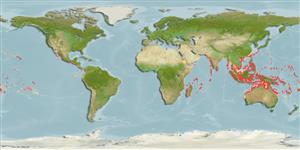Teleostei (teleosts) >
Anguilliformes (Eels and morays) >
Muraenidae (Moray eels) > Muraeninae
Etymology: Gymnothorax: Greek, gymnos = naked + Greek, thorax, -akos = breast (Ref. 45335).
More on author: Bennett.
Environment: milieu / climate zone / depth range / distribution range
Ecology
Marine; brackish; reef-associated; depth range 0 - 50 m (Ref. 90102). Tropical; 30°N - 28°S
Indo-Pacific: Madagascar (Ref. 33390) to the Society Islands, north to southern Japan (Ref. 559), south to Queensland, Australia; throughout Micronesia.
Size / Weight / Age
Maturity: Lm ? range ? - ? cm
Max length : 93.4 cm TL male/unsexed; (Ref. 121652); 87.2 cm TL (female); max. published weight: 1.5 kg (Ref. 121652); max. published weight: 1.5 kg
Vertebrae: 128 - 142. Adults pale with small black spots on face; black spots proportionally much larger in young (Ref. 30404).
Occurs in lagoons, reef flats and seaward reefs (Ref. 1602, 48635). Prefers protected inshore waters among dead corals, common in harbors and small caves (Ref. 30404). Probably nocturnal (Ref. 1602). Feeds on fishes and crustaceans (Ref. 9710). Possibly a protogynous hermaphrodite (Ref. 32169). Current age of a captive individual is 18 years, which exceeds 100 cm and approximately 10 lbs (owner Mark Palermo, pers. comm. 07/12). Minimum depth reported taken from Ref. 86942.
Life cycle and mating behavior
Maturity | Reproduction | Spawning | Eggs | Fecundity | Larvae
Protogyny unconfirmed (Ref. 84746).
Chen, H.-M., K.-T. Shao and C.T. Chen, 1994. A review of the muraenid eels (Family Muraenidae) from Taiwan with descriptions of twelve new records. Zool. Stud. 33(1):44-64. (Ref. 6934)
IUCN Red List Status (Ref. 130435: Version 2024-1)
Threat to humans
Harmless
Human uses
Fisheries: minor commercial
Tools
Special reports
Download XML
Internet sources
Estimates based on models
Preferred temperature (Ref.
123201): 24.9 - 29, mean 28 °C (based on 774 cells).
Phylogenetic diversity index (Ref.
82804): PD
50 = 0.5000 [Uniqueness, from 0.5 = low to 2.0 = high].
Bayesian length-weight: a=0.00040 (0.00027 - 0.00059), b=3.31 (3.20 - 3.42), in cm total length, based on LWR estimates for this species & Genus-body shape (Ref.
93245).
Trophic level (Ref.
69278): 4.0 ±0.67 se; based on food items.
Resilience (Ref.
120179): Low, minimum population doubling time 4.5 - 14 years (Preliminary K or Fecundity.).
Fishing Vulnerability (Ref.
59153): High vulnerability (57 of 100).
Nutrients (Ref.
124155): Calcium = 27.2 [15.0, 53.6] mg/100g; Iron = 0.418 [0.251, 0.797] mg/100g; Protein = 19 [17, 22] %; Omega3 = 0.113 [0.052, 0.306] g/100g; Selenium = 42.3 [22.5, 82.2] μg/100g; VitaminA = 58.3 [17.1, 206.4] μg/100g; Zinc = 1.06 [0.74, 1.47] mg/100g (wet weight);
